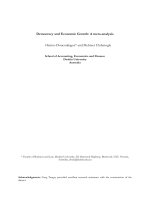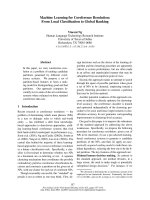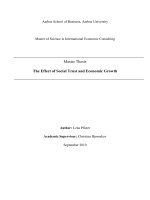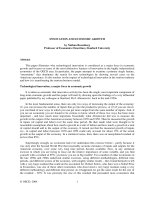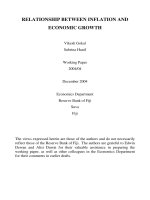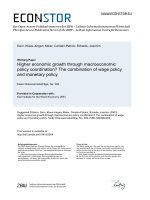WBI LEARNING RESOURCES SERIES: Beyond Economic Growth An Introduction to Sustainable Development An Introduction to Sustainable Development ppt
Bạn đang xem bản rút gọn của tài liệu. Xem và tải ngay bản đầy đủ của tài liệu tại đây (11.61 MB, 211 trang )
Beyond
Economic
Growth
An Introduction to
Sustainable Development
Second Edition
Tatyana P. Soubbotina
The World Bank
Washington, D.C.
WBI LEARNING RESOURCES SERIES
BEG_i-144.qxd 6/10/04 5:18 PM Page i
Copyright © 2004
The International Bank for Reconstruction
and Development/THE WORLD BANK
1818 H Street, N.W.
Washington, D.C. 20433, U.S.A.
All rights reserved
First printing September 2000
The findings, interpretations, and conclusions expressed in this book are entirely those of the author
and should not be attributed in any manner to the World Bank, to its affiliated organizations, or to
members of its Board of Executive Directors or the countries they represent. The World Bank does not
guarantee the accuracy of the data included in this publication and accepts no responsibility for any
consequence of their use. The boundaries, colors, denominations, and other information shown on any
map in this volume do not imply on the part of the World Bank Group any judgment on the legal status
of any territory or the endorsement or acceptance of such boundaries.
The material in this publication is copyrighted. The World Bank encourages dissemination of its work
and will normally grant permission promptly.
Permission to photocopy items for internal or personal use, for the internal or personal use of specific
clients, or for educational classroom use, is granted by the World Bank, provided that the appropriate fee
is paid directly to Copyright Clearance Center, Inc., 222 Rosewood Drive, Danvers, MA 01923, U.S.A.,
telephone 978-750-8400, fax 978-750-4470, www
.copyright.com. Please contact the Copyright
Clearance Center before photocopying items.
For permission to reprint individual articles or chapters, please fax your request with complete
information to the Republication Department, Copyright Clearance Center, fax 978-750-4470.
All other queries on rights and licenses, including subsidiary rights, should be addressed to the
Office of the Publisher, World Bank, 1818 H Street NW, Washington, DC 20433, fax 202-522-2422,
For more information and classroom materials on issues of sustainable development, visit our web
sites at www.worldbank.org/depweb and www
.worldbank.org/wbi/developmenteducation.
Please send comments to
Tatyana P. Soubbotina is a consultant at the World Bank Institute.
Cover and chapter opener design by Patricia Hord Graphic Design. Typesetting by Precision Graphics.
Library of Congress Cataloging-in-Publication Data has been applied for.
BEG_i-144.qxd 6/10/04 1:46 PM Page ii
Acknowledgments vi
Introduction 1
Difficult Questions, Different Answers 2
Data and Development 2
About This Book 3
How to Use The Book 4
1. What Is Development? 7
Goals and Means of Development 7
Sustainable Development 8
2. Comparing Levels of Development 12
Gross Domestic Product and Gross National Product 12
Grouping Countries by Their Level of Development 15
3. World Population Growth 17
4. Economic Growth Rates 23
5. Income Inequality 28
Cross-country Comparisons of Income Inequality 28
Lorenz Curves and Gini Indexes 29
Costs and Benefits of Income Inequality 31
6. Poverty and Hunger 33
The Nature of Poverty 33
The Geography of Poverty 34
The Vicious Circle of Poverty 35
The Challenge of Hunger 38
7. Education 43
Education and Human Capital 43
Primary Education and Literacy 46
Issues in Secondary and Tertiary Education 48
Contents
iii
BEG_i-144.qxd 6/10/04 1:46 PM Page iii
8. Health and Longevity 53
Global Trends 53
Population Age Structures 55
The Burden of Infectious Disease 57
Lifestyle Challenges 61
9. Industrialization and Postindustrialization 63
Major Structural Shifts 63
Knowledge Revolution 65
Implications for Development Sustainability 67
10. Urban Air Pollution 69
Particulate Air Pollution 70
Airborne Lead Pollution 73
11. Public and Private Enterprises: Finding the Right Mix 76
The Dilemma of Public-Private Ownership 77
Is There a Trend toward Privatization? 80
12. Globalization: International Trade and Migration 83
Waves of Modern Globalization 83
Costs and Benefits of Free Trade 85
Geography and Composition of Global Trade 87
International Migration 91
13. Globalization: Foreign Investment and Foreign Aid 95
Private Capital Flows 96
Official Development Assistance 99
14. The Risk of Global Climate Change 102
Whose Responsibility Is It? 103
Will the North-South cooperation work? 107
15. Composite Indicators of Development 110
“Development Diamonds” 110
Human Development Index 111
iv
BEG_i-144.qxd 6/10/04 1:46 PM Page iv
16. Indicators of Development Sustainability 113
Composition of National Wealth 113
Accumulation of National Wealth As an Indicator of Sustainable Development 114
Material Throughput and Environmental Space 117
Social Capital and Public Officials’ Corruption 119
17. Development Goals and Strategies 123
Millennium Development Goals 123
The Role of National Development Policies 127
Difficult Choices 129
Glossary 131
Annex 1: Classification of Economies by Income and Region 145
Annex 2: Data Tables 149
Table 1. Indicators to Chapter 1–5 150
Table 2. Indicators to Chapter 6–7 160
Table 3. Indicators to Chapter 8–9 170
Table 4. Indicators to Chapter 10–13 180
Table 5. Indicators to Chapter 14–16 192
Annex 3: Millennium Development Goals 203
v
BEG_i-144.qxd 6/10/04 5:18 PM Page v
vi
The preparation of this book benefited
greatly from the support and valuable
contributions of many colleagues in the
World Bank Institute (WBI) and in
other parts of the World Bank.
I am particularly indebted to the head
of WBI, Frannie Leautier, for her sup-
port of the second edition of this book
and to two successive managers of the
WBI Development Education Program
(DEP), Katherine Sheram and Danielle
Carbonneau, for the inspiration and
important inputs they provided to this
challenging multiyear project. The work
on this book was also greatly facilitated
by close collaboration with the other
DEP team members, including Evi
Vestergaard, Kelly Grable, and Brooke
Prater.
Next I would like to express my sincere
appreciation to those World Bank
experts who provided extremely useful
comments, suggestions, and inputs dur-
ing the drafting of the first and second
editions of this book: Carl Dahlman,
Dusan Vujovic, Gregory Prakas, Joanne
Epp, John Oxenham, John Middleton,
Kirk Hamilton, Ksenia Lvovsky, Magda
Lovei, Peter Miovic, Philip Karp, Simon
Commander, Tatyana Leonova, Thomas
Merrick, Tim Heleniak, Vinod Thomas,
Vladimir Kreacic, and William Prince.
Special thanks go to John Didier for his
dedicated help with the final editing of
the first edition and unfailing support
during the preparation of the second
edition.
I am also grateful to all of my colleagues
in Russia, Latvia, and Belarus for their
knowledgeable advice during our joint
work on the respective country adapta-
tions of this book, particularly Vladimir
Avtonomov, Andrei Mitskevitch, Erika
Sumilo, and Mikhail Kovalev.
An important role in pilot-testing and
distributing the first edition and its three
country adaptations was played by DEP
partners in the US National Council on
Economic Education (NCEE), in
Russia’s State University–Higher School
of Economics, in the Latvian Association
of Teachers of Economics (LATE), and
in the Belarusian Institute for Post-
Diploma Teacher Training.
Acknowledgments
BEG_i-144.qxd 6/10/04 1:46 PM Page vi
1
The underlying premise of this book is
that in order for development to be sus-
tainable, it has to be comprehensive—it
has to successfully balance economic
goals with social and environmental.
“Development” is really much more
than simply economic growth. The
understanding of development can differ
among countries and even among indi-
viduals, but it usually goes far beyond
the objective of increased average
income to include things like freedom,
equity, health, education, safe environ-
ment, and much more. Hence the title
of this book: “Beyond Economic
Growth.”
By publishing this book, the
Development Education Program
(DEP) of the World Bank Institute
(WBI) seeks to help more people under-
stand that in the present-day globalized
world international development should
be everyone’s concern because it affects
everyone’s life. Ordinary people includ-
ing youth—not just economists and
development experts—should be pre-
pared to discuss and participate in mak-
ing decisions on the most pressing issues
of sustainable development, proceeding
from their own cherished values and
based on reliable data and information
from reputable international sources
(like the World Bank and the UN spe-
cialized development agencies).
This book is designed to introduce read-
ers to some major challenges in today’s
sustainable development (from the global
to the national and perhaps even to the
local level) and help them gain a more
holistic and realistic view of their coun-
try’s situation in a global context.
Because development is a comprehensive
process involving economic as well as
social and environmental changes, this
book takes an interdisciplinary approach.
It attempts to explain some complex rela-
tionships among various aspects of devel-
opment, including population growth,
economic growth, improvements in edu-
cation and health, industrialization and
postindustrialization, environmental
degradation, and globalization. Young
people and learners of all ages, teachers
and students, are invited to explore these
relationships even further—using the sta-
tistical data and theoretical concepts pre-
sented in this book—and to engage in
informed discussions of the controversial
development issues closest to their hearts.
“An Invitation to a Global Discussion”
could be another appropriate subtitle for
this book.
Introduction
BEG_i-144.qxd 6/10/04 1:46 PM Page 1
Difficult Questions,
Different Answers
The book starts with three difficult
questions: What is development? How
can we compare the levels of develop-
ment achieved by different countries?
And what does it take to make develop-
ment sustainable? The author does not
claim to have all the answers to these
and other controversial questions posed
directly or indirectly in the book.
Instead, readers are encouraged to sug-
gest their own answers based on facts—
necessary for understanding the
constraints of reality—but inevitably
rooted in personal value judgments
determining different relevant weights
attached to certain goals and costs of
development by different people. For
example, for some people development
means primarily higher incomes, for
others, a cleaner environment. Some are
most interested in personal security, oth-
ers, in personal freedom. Note that these
goals and values are not always easily
compatible—faster economic growth
may be more damaging to the natural
environment and a strengthening of per-
sonal security may require limiting some
personal freedoms. The abundance of
such tradeoffs in development is one of
the reasons why there are so many open
questions in this book.
Acknowledging that many answers
inevitably involve value judgments,
which makes absolute objectivity impos-
sible, the author has based this book on
one simple ideological principle: devel-
opment should be a tool for improving
the lives of all people. It is up to people
(including the readers of this book) to
define for themselves the meaning of a
better life and to prioritize the goals of
development and the means of their
achievement.
Development Data
Perhaps the main attraction of this book
is that it is based on plentiful statistical
data for most countries, presented in data
tables in Annex 2 as well as in figures,
maps, and references in the text. Statistics
can be powerful tools for learning about
development. They can help paint a
more accurate picture of reality, identify
issues and problems, and suggest possible
explanations and solutions. But statistics
have their limitations too. They are more
reliable for some countries than for oth-
ers. They often allow very different inter-
pretations, particularly when considered
in isolation from other important statis-
tics. And because it takes a long time to
collect and verify some statistics (particu-
larly on a global scale), they may seem to
be or really be out of date before they are
even published. It is also important to
remember that many aspects of develop-
ment cannot be accurately measured by
statistics. Examples include people’s atti-
tudes, feelings, values, ideas, freedoms,
and cultural achievements. Thus statisti-
BEYOND ECONOMIC GROWTH
2
BEG_i-144.qxd 6/10/04 1:46 PM Page 2
cal data can tell us only part of the
story of development—but it is an
important part.
Note that comparing development data
on your country with those on other
countries can be extremely revealing for
several reasons. First, seeing one’s country
in a global context and learning how it is
different from or similar to other coun-
tries can improve understanding of the
country’s present-day status and of its
development prospects and priorities.
Second, because the economies of the
world are becoming increasingly interde-
pendent, development processes in each
country can usually be better understood
when studied in the context of their
interaction with related processes in other
countries. The author hopes that this
book will help satisfy popular demand for
information about global development
and at the same time help readers gain
some new insights into their own coun-
try’s recent past, present, and future.
The statistics presented here were the
most recent available when this book
was written. Most of the data in the data
tables, figures, and maps are from World
Bank publications, including the World
Development Indicators (2000, 2001,
2003), the World Development Report
(various years), and other statistical and
analytical studies. Figures 4.4 and 9.2
have been included with the permission
of the International Monetary Fund.
Some data were also borrowed from the
specialized United Nations agencies,
such as the UN Development Program,
World Health Organization, and UN
Food and Agriculture Organization (as
noted in the text).
About This Book
This book was prepared as part of an
international project under the World
Bank Institute’s Development Education
Program (DEP). The main objective was
to create a template text about the global
issues of sustainable development—
social, economic, and environmental—
that could then be customized for
various countries by teams of local edu-
cators and published in their respective
national languages. It was also expected
that students and other readers inter-
ested in development issues could use
this international template without
adaptation as a source of relatively cur-
rent statistical data and widely accepted
development concepts for further
research and discussions.
The first edition was published in 2000
and simultaneously posted on the DEP
website in the original English and in
French and Spanish translations. The
print copies were distributed in the USA
and internationally, mostly in countries
where students were prepared to read in
English (in Sri Lanka and India, in
Ghana and Uganda, in Lithuania and
Estonia).
INTRODUCTION
3
BEG_i-144.qxd 6/10/04 1:46 PM Page 3
In addition, the first national adaptation
was developed and published in Russia
as The World and Russia student book,
officially approved by the Russian
Ministry of General and Professional
Education for secondary students in the
10th and 11th grades studying econom-
ics, social studies, geography, and envi-
ronmental studies. The three local
coauthors of the Russian adaptation rep-
resented three leading research and edu-
cational institutions in Moscow.
The Latvian adaptation, The World and
Latvia, was prepared in coauthorship
with Erika Sumilo, a professor and
department head at the University of
Latvia, and published in Latvian. The
book was awarded a national prize as the
best Latvian book on economics pub-
lished in 2002.
The latest national adaptation was
undertaken in Belarus in coauthorship
with Mikhail Kovalev, a professor and
department head at Belarus State
University, and was published as The
World and Belarus in 2003. Most of
these Russian-language books were dis-
tributed among secondary schools spe-
cializing in social and humanitarian
studies.
Thanks to the rich history of this book,
the author has had many opportunities to
receive feedback from students and edu-
cators in many countries, developed as
well as developing. Many of their com-
ments were taken into account in the
course of preparing this second edition.
As compared with the first edition, the
second one is completely updated and
revised. All the data and charts are more
current by 4–5 years and new materials
are included on a number of issues such
as Millennium Development Goals, the
nature of poverty, global hunger, the bur-
den of infectious diseases (HIV/AIDS,
TB, malaria), the knowledge revolution,
stages of modern globalization, inter-
national migration, and the costs of
government corruption. Additional con-
troversial questions for further discussion
are included as well. The Development
Education Program hopes that this new
edition will find its way into classrooms
as well as family rooms in many
countries.
How to Use The Book
Because all development issues are intri-
cately interrelated, there is no single,
best sequence in which to study them.
Thus the structure of this book allows
the readers to start with almost any
chapter that they might find the most
intriguing. The author, however, would
advise not skipping Chapters 1 and 2
since they serve as a general introduction
to the book and present some important
basic concepts on which the following
chapters build. Note also that Chapters
15, 16, and 17 can be read as a continu-
BEYOND ECONOMIC GROWTH
4
BEG_i-144.qxd 6/10/04 5:20 PM Page 4
ation of the conceptual discussion
started in the first two chapters. The
other chapters, devoted to particular
development issues, will then allow you
to continue considering the same general
issues in a more concrete manner.
As you read this book, you should keep
in mind the multiplicity of interconnec-
tions among all aspects of sustainable
development. In some cases, these inter-
connections will be explicitly pointed out
in the text (see cross references to other
chapters), while in others readers may
need to identify them on their own.
Questions in the margins are intended
to help readers see the larger and more
complex picture behind the specific data.
Suppose you are most interested in envi-
ronmental issues. Chapters 10 and 14 are
devoted to two different environmental
challenges: local particulate air pollution
in large cities and global air pollution
from carbon dioxide emissions. But to
gain a better understanding of these
issues you will also need to read about
population growth and economic growth
(Chapters 3 and 4), industrialization and
postindustrialization (Chapter 9),
income inequality and poverty (Chapters
5 and 6), and health and longevity
(Chapter 8). These are the most obvious
links, and they are relatively easy to iden-
tify while reading the environmental
chapters. You could also, however, look
into links with all the other chapters in
the book. For example, how does global-
ization (Chapters 12 and 13) affect air
pollution in large cities in developed and
developing countries? Or how does glob-
alization help international efforts to
minimize the risk of global climate
change? You could then explore the links
between privatization and energy effi-
ciency (Chapter 11) or between educa-
tion (Chapter 7) and environmental
protection. Eventually, it becomes clear
that development is so comprehensive
that understanding any one issue
inevitably requires studying all the rest.
Although teachers of various school sub-
jects can use this book to help their stu-
dents understand specific development
issues, students should always be made
aware that no single issue exists in isola-
tion from the others. Ideally, teachers
would use most or all of the book's con-
tent to build one or more learning mod-
ules centered around given curricular
topics. For example, an Air Pollution
module might look like this:
Air Pollution
1. Introduction: Concepts of “develop-
ment” and “sustainable develop-
ment”—Chapters 1, 2, and 16.
2. Local and global air pollution—
Chapters 10 and 14.
3. What are the major causes of the
increasing air pollution?
•Population growth—Chapter 3
•Economic growth—Chapter 4
•Industrialization—Chapter 9
INTRODUCTION
5
BEG_i-144.qxd 6/10/04 1:46 PM Page 5
•Urbanization—Chapter 10
•Income inequality—Chapter 5
•Poverty—Chapter 6
4. Aggravating factors or new
opportunities?
•International trade—Chapter 12
•Foreign investment—Chapter 13
•Foreign aid—Chapter 13
•Privatization—Chapter 11
5. Air pollution as a threat to develop-
ment sustainability:
•Healthy environment as one of
the goals of development—
Chapters 1 and 17
•Natural capital as a component
of national wealth—Chapter 16
• The role of government
policies—Chapter 17.
You will notice that most of a module's
components can be formulated as ques-
tions for discussion. It is up to the reader
to conclude whether, for example, the
effects of economic growth are more
detrimental to the environment than are
the effects of poverty or whether foreign
investment in developing countries con-
tributes to pollution rather than helps
reduce it. The book provides helpful
(although not exhaustive) data and con-
cepts but does not provide any easy
answers.
When discussing questions arising from
this book, it is important to make full
use of the statistics contained in the
data tables (at the end of this book).
Comparing data on different countries
and looking for correlation among vari-
ous indicators can often provide more
insights and food for thought than sim-
ply reading a text.
The author hopes that the discussions
generated by this book will help readers
understand how global and national
development relate to issues in their own
lives, and that this understanding will
lead to practical action at the local level.
Teachers, youth leaders, and other edu-
cators can use this book to inform dis-
cussion about local development
challenges not only among their stu-
dents but also among parents and other
community members. Students can use
the knowledge gained to make better-
informed life choices and to become
more active, involved citizens of their
country as well as global citizens.
***
The World Bank Institute’s Development
Education Program encourages young
people and educators around the world
to visit its web site and send us their
feedback including queries, opinions,
and concerns.
For more information and learning mate-
rials on issues of sustainable development,
visit our web sites at www.worldbank.org/
depweb and www.worldbank.org/wbi/
developmenteducation
Please send comments to
BEYOND ECONOMIC GROWTH
6
BEG_i-144.qxd 6/10/04 1:46 PM Page 6
How do we
determine which
countries are more
developed and
which less?
Are you sure that you know what “devel-
opment” really means with respect to
different countries? And can you deter-
mine which countries are more devel-
oped and which are less?
It is somewhat easier to say which coun-
tries are richer and which are poorer. But
indicators of wealth, which reflect the
quantity of resources available to a soci-
ety, provide no information about the
allocation of those resources—for
instance, about more or less equitable
distribution of income among social
groups, about the shares of resources
used to provide free health and education
services, and about the effects of produc-
tion and consumption on people’s envi-
ronment. Thus it is no wonder that
countries with similar average incomes
can differ substantially when it comes to
people’s quality of life: access to educa-
tion and health care, employment oppor-
tunities, availability of clean air and safe
drinking water, the threat of crime, and
so on. With that in mind, how do we
determine which countries are more
developed and which are less developed?
Goals and Means of Development
Different countries have different priori-
ties in their development policies. But to
compare their development levels, you
would first have to make up your mind
about what development really means to
you, what it is supposed to achieve.
Indicators measuring this achievement
could then be used to judge countries’
relative progress in development.
Is the goal merely to increase national
wealth, or is it something more subtle?
Improving the well-being of the majority
of the population? Ensuring people’s free-
dom? Increasing their economic security?
1
Recent United Nations documents
emphasize “human development,” mea-
sured by life expectancy, adult literacy,
access to all three levels of education, as
well as people’s average income, which is
a necessary condition of their freedom of
choice. In a broader sense the notion of
human development incorporates all
aspects of individuals’ well-being, from
their health status to their economic and
What Is Development?
7
1
1
If you think that the “simple” answer to this question is something like “maximizing people’s happiness,” think
of the different factors that usually make people feel happy or unhappy. Note that a number of special surveys in
different countries appear to show that the average level of happiness in a country does not grow along with the
increase in average income, at least after a certain rather modest income level is achieved. At the same time, in each
country richer people usually reported slightly higher levels of happiness than poorer people, and people in coun-
tries with more equal distribution of wealth appeared to be generally happier.
BEG_i-144.qxd 6/10/04 1:46 PM Page 7
political freedom. According to the
Human Development Report 1996, pub-
lished by the United Nations Develop-
ment Program, “human development is
the end—economic growth a means.”
It is true that economic growth, by
increasing a nation’s total wealth, also
enhances its potential for reducing
poverty and solving other social
problems. But history offers a number of
examples where economic growth was
not followed by similar progress in
human development. Instead growth was
achieved at the cost of greater inequality,
higher unemployment, weakened
democracy, loss of cultural identity, or
overconsumption of natural resources
needed by future generations. As the
links between economic growth and
social and environmental issues are better
understood, experts including econo-
mists tend to agree that this kind of
growth is inevitably unsustainable—that
is, it cannot continue along the same
lines for long. First, if environmental and
social/human losses resulting from eco-
nomic growth turn out to be higher than
economic benefits (additional incomes
earned by the majority of the popula-
tion), the overall result for people’s well-
being becomes negative. Thus such
economic growth becomes difficult to
sustain politically. Second, economic
growth itself inevitably depends on its
natural and social/human conditions. To
be sustainable, it must rely on a certain
amount of natural resources and services
provided by nature, such as pollution
absorption and resource regeneration.
Moreover, economic growth must be
constantly nourished by the fruits of
human development, such as higher
qualified workers capable of technologi-
cal and managerial innovations along
with opportunities for their efficient use:
more and better jobs, better conditions
for new businesses to grow, and greater
democracy at all levels of decisionmaking
(see Fig. 1.1).
Conversely, slow human development
can put an end to fast economic growth.
According to the Human Development
Report 1996, “during 1960–1992 not a
single country succeeded in moving from
lopsided development with slow human
development and rapid growth to a vir-
tuous circle in which human develop-
ment and growth can become mutually
reinforcing.” Since slower human devel-
opment has invariably been followed by
slower economic growth, this growth
pattern was labeled a “dead end.”
Sustainable Development
Sustainable development is a term
widely used by politicians all over the
world, even though the notion is still
rather new and lacks a uniform interpre-
tation. Important as it is, the concept of
sustainable development is still being
developed and the definition of the term
is constantly being revised, extended,
BEYOND ECONOMIC GROWTH
8
BEG_i-144.qxd 6/10/04 1:46 PM Page 8
and refined. Using this book, you can
try to formulate your own definition as
you learn more about the relationships
among its main components—the eco-
nomic, social, and environmental factors
of sustainable development—and as you
decide on their relative significance
based on your own system of values.
According to the classical definition
given by the United Nations World
Commission on Environment and
Development in 1987, development is
sustainable if it “meets the needs of the
present without compromising the abil-
ity of future generations to meet their
own needs.” It is usually understood that
this “intergenerational” equity would be
impossible to achieve in the absence of
present-day social equity , if the eco-
nomic activities of some groups of peo-
ple continue to jeopardize the well-being
of people belonging to other groups or
living in other parts of the world.
Imagine, for example, that emissions of
greenhouse gases, generated mainly by
highly industrialized countries, lead to
global warming and flooding of certain
low-lying islands—resulting in the dis-
placement and impoverishment of entire
island nations (see Chapter 14). Or con-
sider the situation when higher profits of
pharmaceutical companies are earned at
the cost of millions of poor people being
unable to afford medications needed for
treating their life-threatening diseases.
“Sustainable” development could proba-
bly be otherwise called “equitable and
balanced,” meaning that, in order for
development to continue indefinitely, it
should balance the interests of different
1 WHAT IS DEVELOPMENT?
9
Why is equity
important for
sustainable
development?
BEG_i-144.qxd 6/10/04 1:46 PM Page 9
BEYOND ECONOMIC GROWTH
10
groups of people, within the same gener-
ation and among generations, and do so
simultaneously in three major interre-
lated areas–economic, social, and envi-
ronmental. So sustainable development is
about equity, defined as equality of
opportunities for well-being, as well as
about comprehensiveness of objectives.
Figure 1.2 shows just a few of the many
objectives, which, if ignored, threaten to
slow down or reverse development in
other areas. You are invited to add more
objectives and explain how, in your opin-
ion, they are connected to others. In the
following chapters you will find many
examples of such interconnections.
Obviously, balancing so many diverse
objectives of development is an enormous
challenge for any country. For instance,
how would you compare the positive
value of greater national security with the
negative value of slower economic growth
(loss of jobs and income) and some, pos-
sibly irreversible, environmental damage?
There is no strictly scientific method of
performing such valuations and compar-
isons. However, governments have to
make these kinds of decisions on a regular
basis. If such decisions are to reflect the
interests of the majority, they must be
taken in the most democratic and partici-
patory way possible. But even in this case,
there is a high risk that long-term inter-
ests of our children and grandchildren
end up unaccounted for, because future
generations cannot vote for themselves.
Thus, to ensure that future generations
inherit the necessary conditions to pro-
vide for their own welfare, our present-
day values must be educated enough to
reflect their interests as well.
BEG_i-144.qxd 6/10/04 1:46 PM Page 10
The challenge is further complicated by
the fact that in today’s interdependent
world many aspects of sustainable devel-
opment are in fact international or even
global. On the one hand, many deci-
sions taken at the national or even local
level actually have international conse-
quences–economic, social, environmen-
tal. When these consequences are
negative, the situation is sometimes
referred to as “exporting unsustainabil-
ity.” On the other hand, national poli-
cies are often inadequate to effectively
deal with many challenges of sustainabil-
ity. Thus international cooperation on
the wide range of so-called transbound-
ary and global problems of sustainable
development becomes indispensable.
Arguably, the most critical problem of
sustainable development—in each
country as well as globally—is eradicat-
ing extreme poverty. That is because
poverty is not only an evil in itself. It
also stands in the way of achieving most
other goals of development, from clean
environment to personal freedom.
Another, closely related, global problem
is establishing and preserving peace in
all regions and all countries. War, as
well as poverty, is inherently destructive
of all economic as well as social and
environmental goals of development
(see Fig. 1.2).
In the final analysis sustainable develop-
ment is about long-term conditions for
humanity’s multidimensional well-being.
For example, the famous Rio
Declaration, adopted by the United
Nations Conference on Environment
and Development in 1992 (also called
the Earth Summit, held in Rio de
Janeiro, Brazil), puts it this way:
“Human beings are at the center of con-
cern for sustainable development. They
are entitled to a healthy and productive
life in harmony with nature.”
1 WHAT IS DEVELOPMENT?
11
What are the
necessary
conditions for
sustainable
development?
BEG_i-144.qxd 6/10/04 1:46 PM Page 11
Countries are unequally endowed with
natural resources. For example, some
countries benefit from fertile agricultural
soils, while others have to put a lot of
effort into artificial soil amelioration.
Some countries have discovered rich oil
and gas deposits within their territories,
while others have to import most “fossil”
fuels. In the past a lack or wealth of nat-
ural resources made a big difference in
countries’ development. But today a
wealth of natural resources is not the
most important determinant of develop-
ment success. Consider such high-income
countries as Japan or the Republic of
Korea. Their high economic development
allows them to use their limited natural
wealth much more productively (effi-
ciently) than would be possible in many
less developed countries. The productiv-
ity with which countries use their pro-
ductive resources—physical capital,
human capital, and natural capital—is
widely recognized as the main indicator
of their level of economic development.
Theoretically, then, economists compar-
ing the development of different coun-
tries should calculate how productively
they are using their capital. But such cal-
culations are extremely challenging, pri-
marily because of the difficulty of
putting values on elements of natural
and human capital. In practice econo-
mists use gross national product
(GNP) per capita or gross domestic
product (GDP) per capita for the same
purpose. These statistical indicators are
easier to calculate, provide a rough mea-
sure of the relative productivity with
which different countries use their
resources, and measure the relative mate-
rial welfare in different countries,
whether this welfare results from good
fortune with respect to land and natural
resources or from superior productivity
in their use.
Gross Domestic Product
and Gross National Product
GDP is calculated as the value of the
total final output of all goods and ser-
vices produced in a single year within a
country’s boundaries. GNP is GDP plus
incomes received by residents from
abroad minus incomes claimed by non-
residents.
There are two ways of calculating GDP
and GNP:
•By adding together all the incomes
in the economy—wages, interest,
profits, and rents.
12
2
Comparing Levels
of Development
BEG_i-144.qxd 6/10/04 1:46 PM Page 12
•By adding together all the expendi-
tures in the economy—consumption,
investment, government purchases of
goods and services, and net exports
(exports minus imports).
In theory, the results of both calculations
should be the same. Because one person’s
expenditure is always another person’s
income, the sum of expenditures must
equal the sum of incomes. When the cal-
culations include expenditures made or
incomes received by a country’s citizens in
their transactions with foreign countries,
the result is GNP. When the calculations
are made exclusive of expenditures or
incomes that originated beyond a coun-
try’s boundaries, the result is GDP.
GNP may be much less than GDP if
much of the income from a country’s
production flows to foreign persons or
firms. For example, in 1994 Chile’s
GNP was 5 percent smaller than its
GDP. If a country’s citizens or firms hold
large amounts of the stocks and bonds of
other countries’ firms or governments,
and receive income from them, GNP
may be greater than GDP. In Saudi
Arabia, for instance, GNP exceeded
GDP by 7 percent in 1994. For most
countries, however, these statistical indi-
cators differ insignificantly.
GDP and GNP can serve as indicators of
the scale of a country’s economy. But to
judge a country’s level of economic devel-
opment, these indicators have to be
divided by the country’s population.
GDP per capita and GNP per capita
show the approximate amount of goods
and services that each person in a country
would be able to buy in a year if incomes
were divided equally (Figure 2.1). That is
2 COMPARING LEVELS OF DEVELOPMENT
What are the main
limitations of per
capita income as a
measure of
development?
13
BEG_i-144.qxd 6/10/04 1:46 PM Page 13
why these measures are also often called
“per capita incomes.”
In the data tables at the end of this book
GNP per capita is shown not only in
U.S. dollars but also in PPP dollars—
that is, adjusted with the help of a
purchasing power parity (PPP) con-
version factor. The PPP conversion fac-
tor shows the number of units of a
country’s currency required to buy the
same amount of goods and services in
the domestic market as one dollar would
buy in the United States. By applying
this conversion factor, one can, for
example, convert a country’s nominal
GNP per capita (expressed in U.S. dol-
lars in accordance with the market
exchange rate of the national currency)
into its real GNP per capita (an indica-
tor adjusted for the difference in prices
for the same goods and services between
this country and the United States, and
independent of the fluctuations of the
national currency exchange rate). GNP
in PPP terms thus provides a better
comparison of average income or con-
sumption between economies.
In developing countries real GNP per
capita is usually higher than nominal
GNP per capita, while in developed
countries it is often lower (Table 2.1).
Thus the gap between real per capita
incomes in developed and developing
countries is smaller than the gap
between nominal per capita incomes.
Although they reflect the average
incomes in a country, GNP per capita
and GDP per capita have numerous lim-
itations when it comes to measuring
people’s actual well-being. They do not
show how equitably a country’s income
is distributed. They do not account for
pollution, environmental degradation,
and resource depletion. They do not reg-
ister unpaid work done within the fam-
ily and community, or work done in the
shadow (underground and informal)
economy. And they attach equal impor-
tance to “goods” (such as medicines) and
“bads” (cigarettes, chemical weapons)
while ignoring the value of leisure and
human freedom. Thus, to judge the rela-
tive quality of life in different countries,
one should also take into account other
indicators showing, for instance, the dis-
tribution of income and incidence of
poverty (see Chapters 5 and 6), people’s
health and longevity (Chapter 8) and
access to education (Chapter 7), the
quality of the environment (Chapter
10), and more. Experts also use compos-
BEYOND ECONOMIC GROWTH
14
Table 2.1 Nominal and real GNP per capita in various
countries, 1999
GNP per capita GNP per capita
Country (U.S. dollars) (PPP dollars)
India 450 2,149
China 780 3,290
Russia 2,270 6,339
United States 30,600 30,600
Germany 25,350 22,404
Japan 32,230 24,041
BEG_i-144.qxd 6/10/04 1:46 PM Page 14
ite statistical indicators of development
(Chapter 15).
Grouping Countries by Their
Level of Development
Different organizations use different cri-
teria to group countries by their level of
development. The World Bank, for
instance, uses GNP per capita to classify
countries as low-income (GNP per
capita of $765 or less in 1995), middle-
income (including lower-middle-
income, $766 to $3,035, and upper-
middle-income, $3,036 to $9,385),
or high-income ($9,386 or more;
Map 2.1).
A more popular, though apparently more
disputable, approach involves dividing all
countries into “developing” and “devel-
oped”—despite the general understand-
ing that even the most developed
countries are still undergoing develop-
ment. Dividing countries into “less devel-
oped” and “more developed” does not
help much, because it is unclear where to
2 COMPARING LEVELS OF DEVELOPMENT
What problems are
associated with
dividing countries
into “developed”
and “developing”?
15
BEG_i-144.qxd 6/10/04 1:46 PM Page 15
draw the line between the two groups. In
the absence of a single criterion of a
country’s development, such divisions can
only be based on convention among
researchers. For example, it is conven-
tional in the World Bank to refer to low-
income and middle-income countries as
“developing,” and to refer to high-income
countries as “industrial” or “developed.”
The relatively accurate classification of
countries into “developing” and “devel-
oped” based on their per capita income
does not, however, work well in all cases.
There is, for instance, a group of “high-
income developing countries” that
includes Israel, Kuwait, Singapore, and
the United Arab Emirates. These coun-
tries are considered developing because
of their economic structure or because of
the official opinion of their govern-
ments, although their incomes formally
place them among developed countries.
Another challenge is presented by many
of the countries with “transition” or “for-
merly planned” economies—that is,
countries undergoing a transition from
centrally planned to market economies.
On the one hand, none of these coun-
tries has achieved the established thresh-
old of high per capita income. But on
the other, many of them are highly
industrialized. This is one reason their
classification by the World Bank is cur-
rently “under review.” Note that in the
World Bank’s World Development Report
1982 these same countries were classi-
fied as “industrial nonmarket,” and in
current United Nations publications
most of them are still grouped among
“industrial” countries.
BEYOND ECONOMIC GROWTH
16
BEG_i-144.qxd 6/10/04 1:46 PM Page 16
Why is world
population
growing faster
than ever before?
When will it
stabilize?
17
3
Population dynamics are one of the key
factors to consider when thinking about
development. In the past 50 years the
world has experienced an unprecedented
increase in population (see Fig. 3.1). Do
you know why?
A “natural population increase” occurs
when the birth rate is higher than the
death rate. While a country’s popula-
tion growth rate depends on the natural
increase and on migration, global popu-
lation growth is determined exclusively
by the natural increase.
Around the world, death rates gradually
decreased in the late 19th and the 20th
centuries, with death rates in developing
countries plummeting after World War II
thanks to the spread of modern medicine
that allowed control of infectious diseases.
In much of the developing world the
decline in death rates preceded the decline
in birth rates by 20 years or more (see
Fig. 3.2), resulting in record-high rates
of population growth of 3 percent or even
4 percent a year. Since the 1960s birth
rates have also been declining rapidly in
most developing countries except those in
Sub-Saharan Africa and the Middle East.
This decrease in birth rates in the devel-
oping world is even more rapid than that
characteristic of Europe and the United
States in the 19th century.
World Population Growth
BEG_i-144.qxd 6/10/04 1:46 PM Page 17
BEYOND ECONOMIC GROWTH
18
Today’s low-income countries still have
the world’s highest birth rates (see Map
3.1), although women tend to have fewer
children than before. The reasons for
lower fertility are varied, but most are
related to developing countries’ eco-
nomic growth and development (see Fig.
3.3; see also Chapters 4, 7, 8). Parents
choose to have smaller families when
health conditions improve because they
no longer have to fear that many of their
babies might die, and when they do not
have to rely on their children to work on
the family farm or business or to take care
of them in their old age. In addition,
more parents are sending their daughters
to school, which is important because
women with basic education tend to pro-
duce healthier children and smaller fami-
lies. More women now have
opportunities to work outside the home,
so they are starting their families later and
having fewer children. On top of all that,
access to modern contraceptives for fam-
ily planning is improving, making it eas-
ier for parents to control the number and
spacing of their children.
Lower fertility rate does not immediately
lead to lower birth rate and lower popula-
tion growth rate if a country has a larger
proportion of men and women in their
reproductive years than before. Population
growth caused by more women giving
birth even though each has the same
number of or fewer children is called
“population momentum.” Population
momentum is particularly significant in
developing countries that had the highest
fertility rates 20 to 30 years ago.
BEG_i-144.qxd 6/10/04 1:46 PM Page 18
3 WORLD POPULATION GROWTH
19
The decline in birth rates over the past
few decades has lowered population
growth rates in developing countries
despite a continuing decline in death
rates. Population growth is even slower
in developed countries (see Fig. 3.4).
Stabilizing birth rates and increasing
death rates (the latter being a result of
aging populations, see Chapter 8) have
already led to a natural population
decrease in Italy and Germany. Japan
and Spain are expected to follow soon.
(see birth rates and death rates in Data
Table 1).
The formerly socialist countries of
Central and Eastern Europe present a
major exception to the broad similarity
of demographic trends in developed and
developing countries. The rapid decline
in death rates that occurred in the 1950s
and 1960s slowed down in the 1970s
and 1980s. In the 1990s death rates
actually increased in Russia and some
other transition countries, including
Belarus, Bulgaria, Estonia, Latvia,
Lithuania, Moldova, Romania, and
Ukraine. In the late 1990s death rates in
these middle-income countries exceeded
BEG_i-144.qxd 6/10/04 1:46 PM Page 19
